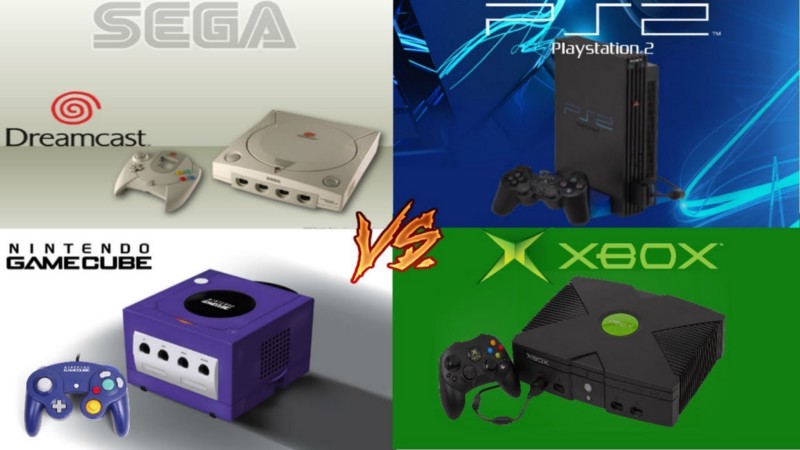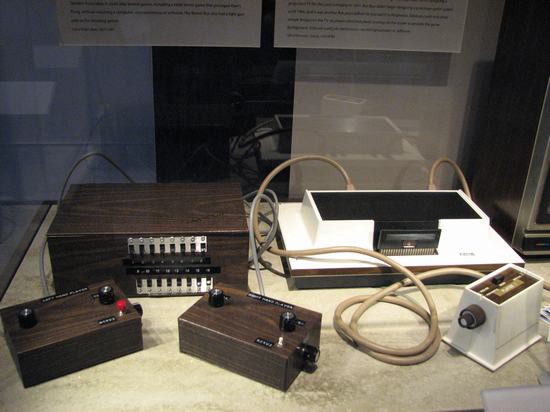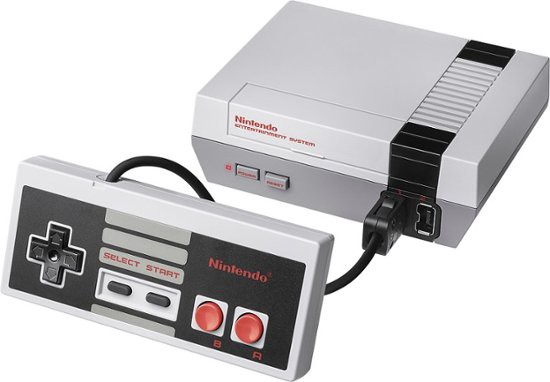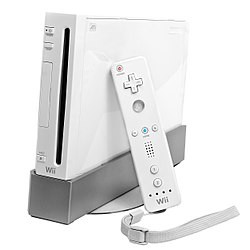How console wars spurred the progress of consoles and video games
- Transfer

Since consoles began to gain popularity and began to appear in homes around the world, they have occupied a special place in the hearts of people. So big that players began to identify with their consoles. Therefore, when their favorite consoles appeared competitors, it was perceived as a declaration of war. Disputes began to arise about which of the consoles is “better”; they continue to this day. And although it can be considered infantilism, it is still impressive how passionately people relate to their consoles, which influenced their lives. In this article I will analyze and describe the history of consoles and console wars, and also talk about how this story influenced the appearance of those consoles that we know today.
In order to analyze when the competition that led to these “console wars” began, it is best to start with how the consoles appeared at all.
The birth of the home console
At the beginning of the video game era, the idea of acquiring home game consoles was far from the needs of American society. Computer games were the first to make the idea of a home game console more realistic. The invention of games such as OXO by British professor A.S. Douglas (1952), Tennis for Two by William Higginbotham (1958) and Spacewars! Stephen Russell (1962) (the first game to play on multiple computers), has become a catalyst for the creation of game consoles and video games in general.
All these games were big steps for video games to their home consumers, but not one of them had such an impact as Brown Box. Ralph Baer and his colleagues at Sanders Associates have created a prototype of the world's first video game console, originally called “TV Game Unit # 7.” The Brown Box had a wide range of games, including checkers, target shooting, many sports, and the most popular was ping pong. To start the game in Brown Box, switches and “Program Cards” were used, which indicated the position of the switches necessary for each game. Ralph Baer is often called the father of video games, because the innovative Brown Box first implemented functions that are available in modern consoles, for example, several controllers and the ability to run different games.

The first Brown Box prototype (left) and the Magnavox Odyssey home console (right).
Magnavox Odyssey was not as successful as the company had expected, but after the launch of the home console on the market, the appearance of other companies' consoles was only a matter of time.
The first major player to start the era of home consoles - Atari. After the success of the home version of PongAtari released the 1977 Video Computer System, created by Nolan Bushnell, which is better known to us as the Atari 2600. It could be considered a competitor to the Magnavox Odyssey, but there was no competition - Atari was far ahead of it in technology and sales, despite Magnavox trying to release improved versions Odyssey. In addition, Atari and Magnavox became a kind of partners - after a lawsuit against Atari for copyright infringement ( Pong was very similar to ping-pongcompany Magnavox) the company decided to purchase a license for Odyssey: "you can not pay - join." The Atari 2600 was the starting point for a new generation of consoles, which caused real chaos in the video game industry, especially in the game console market. In turn, this led to the fact that the industry was open to a single system that has gained immense prestige in the gaming industry.
The Great Crisis of Video Games
After an intriguing success, many companies wanted to get their chunk of profits. This led to the release by various companies of a huge number of consoles: Mattel, Colecon, Nintendo - this is only a small part of the list. However, this gold rush had terrible side effects for the home console industry. The congestion in the console market and the poor quality of games ultimately led to one of the most notorious crises in video game history. By 1983, confusion began to reign in the home console market - a bunch of console options, but they were all of poor quality, not to mention the quality of their games. One of the saddest examples was the ET video game.Atari, sometimes exaggeratedly called the sole cause of the video game crisis. Be that as it may, it is believed that it was she who led to the collapse of Atari. This game was an excellent reflection of the way of thinking that prevailed in the gaming industry before the crisis: it was created in a hurry and was made in just six weeks (publishers were in a hurry to release it for the impending Christmas season). Today, it is considered by many to be one of the worst games in history. This attitude, which at that time dominated game developers, led to the decline of the vast majority of companies in the home console market. At that moment, when all hopes for home consoles were at an all-time low, one company finally realized that people value quality as much, and maybe more than quantity.
Nintendo appears on stage
It was then that Nintendo became a landmark franchise in the history of game consoles and console wars. Nintendo, which has already managed to closely explore the North American gaming industry thanks to its Donkey Kong arcade hit, who first introduced America to the famous Mario, decided to get involved in the battle. Entering the North American market of the Japanese Famicom console (1985), better known in America as the Nintendo Entertainment System (NES), was a smart and thoughtful process of taking control of the US gaming market. At a time when US consumers were just feeling the collapse of the industry, Nintendo decided to develop a console that was unlike anything that the American audience had seen before. In fact, Nintendo even avoided using the term “video game” in its first marketing materials because it could scare consumers away. That is why the console was called the "entertainment system" (entertainment system) - the company wanted it to be perceived as a more complex technological device. And she had the right to it: at that time, NES was the best and most modern 8-bit console on the market. This fact, as well as various requirements imposed by the company on game developers for its system, led to the fact that NES has earned worldwide success. Success, which will be the birth of rivalry, which went down in the history of video games as the first console war.

Released in 1985, the Nintendo Entertainment System
First console war: Nintendo vs. Sega
In 1989, Nintendo was at the top of the gaming market. After the release of GameBoy, it was hard to imagine how anyone else could compete with Nintendo for leadership in video games. In addition, Nintendo has released many hit games that continue to remain, such as Mega Man , Super Mario Bros. , The Legend of Zelda and many others. However, it was precisely the year 1989 when the first real competitor appeared - Sega and its 16-bit console Sega Genesis.
Sega did not succeed in competing with NES with its previous consoles (1983 Sega SG-100, 1985 Sega Master System), but finally found a way to thwart NES leadership. Thanks to smart marketing, Sega has become a direct competitor to Nintendo, remembered for its loudest slogan "Genesis does what Nintendon't."
The famous ad Genesis does what Nintendon't.
In response to Sega's success, Nintendo has released its own 16-bit SNES (Super Nintendo Entertainment System) console. Thanks to the release for her of Street Fighter 2 (then the popular arcade game fighting game developed by Capcom), this was enough to compete with Sega. Between them began a contest: who will be able to release the best games. Both companies had characters loved by fans - the hedgehog Sonic and Mario, but sales promoted third-party games. In 1993, Mortal Kombat appeared on both consoles . To get a softer, “family” rating, the game became less cruel: on both consoles, the blood was replaced with sweat and the number of fatalities was reduced. However on sega uMortal Kombat was a cheat code that allowed players to include blood and brutal graphic content, giving Genesis an edge in selling this game and console.
Sega became known for its defiant aggressiveness, it never missed the opportunity to fake Nintendo in advertising. Although the Super Nintendo hardware was more advanced, the console had a lot of processing power issues, which made some games slow down. By coincidence or not, the expression “blast processing” has become another famous Sega Genesis slogan. The company cleverly used its beloved Sonic to emphasize the great speed and processing power of the console.
Sega uses the term Blast Processing, 1993, in his ad.
Sega not only tried to conquer the world of consoles, but also rushed to the portable gaming market. She tried to get around the famous GameBoy in sales by introducing her own Sega Game Gear console. Not surprisingly, Sega showed everything that Game Gear was better than Game Boy in advertising, for example, more convenient operation and a full-color screen. However, this battle was much less successful than in the case of Sega Genesis - thanks to the famous Tetris game, the GameBoy console managed to stay on top of sales.
Although Sega Genesis was successful in the United States, it never managed to compete with SNES in the international market, so overall, SNES and Nintendo continued to excel in the video game industry; 49.1 million devices were sold worldwide.
Nintendo managed to win this round of console wars, but the war only began when a new competitor appeared on the market. Advances in technology and games have led to the emergence of a new generation of consoles. The era of 3D and CD has arrived in the gaming industry, and Sony PlayStation has been at the forefront of this movement.
Console Wars 2: A New Challenger Appears
After breaking the contract between Nintendo and Sony on the creation of an additional device with CD-Rom for SNES, Sony decided to create its own console. The PlayStation was released in 1995, but it was not the first console with innovative CD capabilities - Sega was able to release its Sega Saturn system a couple of months before the Playstation, but in the end it turned out to be a failure and was the beginning of the end of Sega's production career consoles. Playstation, although it was released a few months after Saturn, was $ 100 cheaper, which gave it a significant advantage. Along with the price and revolutionary 3D graphics of the PlayStation, Sony has carefully studied the marketing of Sega, starting to advertise the strengths and sophistication of its console. A year later, Nintendo released its new Nintendo 64 console. The most noticeable changes in it were support for up to four controllers for multiplayer games and a new joystick that simplified navigation in 3D games. Despite the fact that, unlike competing devices, N64 did not use CDs, but cartridges, the console proved to be much better than Sega Saturn, which suffered a terrible failure and sold just 9.5 million copies. But 33 million Nintendo devices sold could not be compared with the newcomer - the PlayStation convincingly won this console war, becoming the first console to sell more than 100 million units. This crushing victory was primarily caused by the large assortment of games available on the console. Even despite the fact that on the Nintendo 64 appeared some of the most important and beloved gamers games likeSuper Mario 64 and Legend of Zelda: Ocarina of Time , she could not compete with the enormous third-party support received by the PlayStation. In total, Sony managed to sell 102.49 million devices and this was a huge success for a newcomer to the gaming industry.
PlayStation ads that appeal to the coolness of this console.
Console Wars 3: Sony continues to dominate
Sony has been able to extend its success in the next generation of consoles. PlayStation 2 was released in 2000 and has become the best-selling console of all time - 150 million devices have been sold. Again, the main reasons for buying the console were games and innovations. PS2 was the first DVD-enabled console, which was new technology at the time. In addition, PS2 was supported in the form of excellent games, including such exclusives as Grand Theft Auto and Gran Turismo, and again received huge support from third-party developers. The Nintendo GameCube and the first Microsoft console, dubbed the Xbox, were great consoles that attracted a portion of the audience, but over the entire life span of both companies managed to sell just over 20 million devices. This was not enough to remove the PlayStation from the throne on which she had previously seated herself.
Sega Dreamcast, released worldwide in 1999, became the latest Sega console, after which it became a game developer for third-party platforms. Despite the fact that thanks to innovations (for example, Dreamcast was the first console with an Internet connection), she managed to gain a loyal fan base, which exists to this day, Sega never managed to achieve her previous success. Many believe that the main reason was the too frequent release of new Sega consoles; but be that as it may, Dreamcast sold even less than Saturn, and on March 1, 2001, Sega stopped production. Dreamcast is the last console released by Sega.

Further console wars
In the most recent of the console wars, Nintendo saw the opportunity to return to the top again using the Nintendo Wii. Microsoft and the PlayStation fought in their own battle against each other: from a technological point of view, the PlayStation 3 and Xbox 360 were comparable. However, the beginning of the console war for Sony was quite unpleasant - the initial PS3 price of $ 600 seemed too high, and marketing seemed unceremonious. The Xbox was able to start successfully thanks to a cheaper console and excellent support for online features. Towards the end of the battle, Sony was able to turn the situation in its favor, lowering prices and creating an excellent line of games, the most notable of which was The Last of US. Both the Xbox 360 and PS3 sold approximately 80 million consoles. You may wonder what happened to the Wii at this time. In this war, she achieved serious sales and soared to the top. In terms of hardware, the Wii turned out to be weak compared to its high-tech competitors, and one would think that this would affect its results, but everything turned out the other way around. It was the simplicity of the Wii that gave her an edge over her rivals. Simple but innovative gesture control was easy enough for anyone to play games. And in fact everyone played them - grandmothers, mothers and fathers; no console has been able to attract such a variety of players. Despite the low popularity of Wii among more hardcore gamers, its success was undeniable; she went down in history

Nintendo Wii was the first to succeed thanks to its simple yet innovative controls.
The current generation of consoles so far shows that history is repeating itself. Three titans of the console industry — Sony, Microsoft, and Nintendo — are so ingrained in the industry that it’s hard to imagine a new generation of consoles without them. Sony Playstation 4 is currently at the top thanks to a good start and reasonable pricing - the company took PS3 lessons into account. The situation has changed for Microsoft - initially the Xbox One was sold at a higher price, and marketing basically positioned the Xbox One as an entertainment rather than a gaming system. The new generation of Nintendo consoles began with Wii U, which turned out to be a failure and its success can not be compared with Wii. Soon, Microsoft and Nintendo corrected their mistakes: Microsoft cut prices, and a new Nintendo system called Nintendo Switch performed quite well.
The future of games and consoles
After the announcement of the release of new consoles by Sony and Microsoft this year, it will be interesting to look back and see how far the consoles have managed to go thanks to the rivalry. At first it was SNES and Sega Genesis, which not only made the games interesting, but also gave the players a sense of community. Although these console wars took the form of rivalry, they created the component necessary for the development of video games - competition. The same competition showed the world, using the Sony PlayStation as an example, what impact the console could have, and it also led to the end of Sega's competition in the console market. Whatever the outcome of these console wars, they allowed the gaming community to become what it is now, influencing millions of gamers in the process of development. Gradually, the mutual compatibility of games begins to appear, which allows people to play together with different consoles, but most often against each other. It also looks like a war.
Note: you can argue who became the winner in a particular war of consoles by comparing their games and hardware. But for the sake of simplicity, I just decided to consider the number of devices sold.
Sources
Video Game History. History.
Console Wars: A History of Violence. PCmag.
Here's Who Won Each Console War. Venturebeat.
A History of Console Wars. Pojo
Sega and Nintendo Console War: Greatest Moments. Primagames
Ten Facts About The Great Video Game Crash of '83. IGN.
Evolution of Home Video Game Consoles: 1967–2011. Hongkiat.
The Brown Box, 1967–68. Americanhistory.
Console Wars: A History of Violence. PCmag.
Here's Who Won Each Console War. Venturebeat.
A History of Console Wars. Pojo
Sega and Nintendo Console War: Greatest Moments. Primagames
Ten Facts About The Great Video Game Crash of '83. IGN.
Evolution of Home Video Game Consoles: 1967–2011. Hongkiat.
The Brown Box, 1967–68. Americanhistory.
